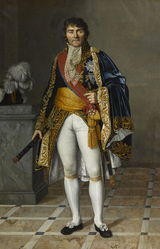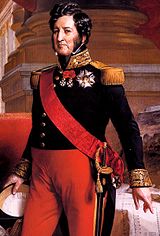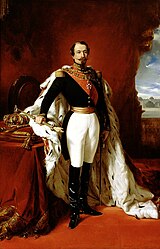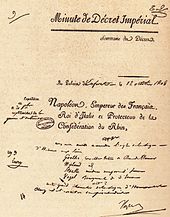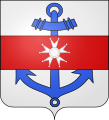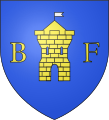Legion of Honor

The Legion of Honor ( French Légion d'honneur , completely L'ordre national de la Légion d'honneur ) is a French order of merit . The order was founded on May 19, 1802 by Napoleon Bonaparte , at that time still First Consul, with the intention of rewarding military and civil service, excellent talents and great virtues. No citizen is excluded from this order because of his or her birth, class or religion. The Legion of Honor is the most prestigious award in France. In civilian clothes, the miniature is worn as a red ribbon or a red rosette in the buttonhole, depending on its rank .
history
The French Revolution of 1789 changed the labeling system fundamentally. The order system of the nobility was abolished in France. However, the new order did not want to do without a labeling system. The administrative and state authorities created by the revolutionary transformation were based on the active cooperation of representatives of the lower classes of the population. In the coalition wars that were waged against France, it seemed necessary to create awards that expressed the will to perform of the mass armies ( levée en masse ) and, above all, served motivation. Due to the changed social structures, the order system from dynastic times could not be used. Rewards took the form of gifts of money or the award of honorary weapons in the form of engraved rapiers and sabers.
The Legion of Honor, based on an idea of Napoleon Bonaparte, was brought into being in the National Assembly in 1802. The Legion of Honor considered civil and military merits equally. Orientation was provided by Roman models, which was also reflected in the names. The Legion consisted of 16 cohorts, corresponding to the number of regional regions . Each of them numbered 350 legionaries, 30 officers, 20 commanders and 7 grand officers. The Grand Council presided over the cohorts; Chief of the Council and the Legion was the First Consul. Anyone could be accepted into the Legion regardless of rank or status and regardless of religious affiliation. Acceptance and membership represented the award. Until 1804 there were also no visible insignia to be worn.
Change from knightly order to order of merit
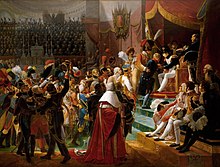
The award differed fundamentally from the order of the Ancien Régime and in this form corresponded to the social needs and requirements of the consular period. When Napoleon was crowned emperor in 1804, the statutes of the Legion of Honor were also changed. It was converted into an Order of Merit by an organization. In the following years there was a five-tier division into grand cross (maximum 75), grand officer (maximum 250), commander (maximum 1,250), officer (maximum 10,000) and knight (maximum 125,000), which deviated from the single or three-tiered order of previous orders . An expression of the national significance of this award is its existence through political and temporal change up to the present. As a civil and military order of merit, it was and is open to all persons regardless of rank or position. Over the years only modifications of the award or changes in size and image as well as the motto in the medallion of the medal were made. The changes corresponded to the respective political environment. From 1871 to 1912 the symbol of the Legion of Honor was also part of the state coat of arms of the Third Republic .
International role model function

The Legion of Honor as an outward sign of social change was also a model for other countries' award systems. The development of Europe was strongly influenced by the French Revolution, the effects of the coalition wars and the Napoleonic Wars. States that were dependent on or occupied by France took over parts of the civil society structures. In the monarchical countries of Germany, too, the number of orders for merit increased in the 19th century. Although the nobility was no longer a requirement for award, the high classes (Grand Cross and Commander) were still tied to rank and status. In the 19th century, the award system was characterized by a large number of foundations. From 1800 to 1945, 3,500 state wearable awards of all categories and classes were created in the German states. Merit awards were created for a wide range of performance and merit in various areas, professions, offices and positions. Achievements in the scientific and technical field, in industrial development and in dealing with administrative tasks were recognized with the award of the Order of Merit. From a political point of view, representatives of the bourgeoisie became recognized forces in society in the 19th century.
Many orders were expanded to include a fourth class or a medal or a cross. In technical terms, these decorations that are attached to an order are called affiliated medals or crosses. Lower professional groups in the state apparatus and lower ranks in the military could also benefit from awards. Awards of medals to workers or peasants remained an exception. Foundations and statutes, class division and award modalities as well as the design and form of the orders of the 19th century were given by the German princes in terms of content. They were aimed at the appreciation of achievements to preserve monarchical structures. Awards to representatives of the bourgeoisie are within the monarchical system an expression of the appreciation of their work in the political, economic, scientific and cultural fields.
Order classes
In addition to the Grand Maître , a level reserved for the head of state (he wears the collar with medals) as official insignia, there are five levels of the order.
- Special awards
-
 Grand Cross - Grand-croix de la Légion d'Honneur, previously Grande Décoration , Grand Aigle or Grand Cordon ; Order star on the left breast, with an order ribbon worn over the right shoulder
Grand Cross - Grand-croix de la Légion d'Honneur, previously Grande Décoration , Grand Aigle or Grand Cordon ; Order star on the left breast, with an order ribbon worn over the right shoulder -
 Grand Officer - Grand Officier de la Légion d'Honneur; Medal on a ribbon, worn on the left breast, plus a star on the right breast
Grand Officer - Grand Officier de la Légion d'Honneur; Medal on a ribbon, worn on the left breast, plus a star on the right breast
-
- Three ranks
Groups and communities can also be awarded the Legion of Honor à titre collectif , for example schools, military academies and regiments and especially cities. Of the latter, more than 60 were awarded the Legion of Honor because they had to suffer in particular from combat operations or were characterized by particular collective resistance against the enemy.
Salary of honor
To this day, an honorary salary is associated with acceptance into the Legion of Honor . The annual bonus has remained almost unchanged since it was founded until the middle of the 19th century.
It received a
- Legionnaire ( légionnaire , renamed to Ritter / chevalier in 1808 ): 250 gold francs (F)
- Officer ( officier ): 1000 F
- Commander ( commandant , since 1816 Kommandeur / commandeur ): 2000 F
- Grand officier : 5000 F
- Großer Adler ( grand-aigle , since 1805) / Großes Band ( grand-cordon , during the first restoration in 1814) / Großkreuz ( grand-croix , 1816): 20,000 F
The honorary pay meant a considerable increase in civil or military salaries. In 1805, for example, an ordinary infantryman received around 100 F per year, a sub-lieutenant 1000 F, a captain 2000 F, a colonel 5000 F and a division general 20,000 F.
Napoleon III reduced the pension amount for all levels of the order, with the exception of knights, in 1852. From then on, the
- Officer: 500 F
- Commander: 1000 F
- Grand Officer: 2000 F
- the grand cross: 3000 F
Today the honorary salary is only symbolic, since inflation has not been compensated for since the end of the 19th century . A reduction in the nominal value in 1960 meant the conversion from old francs to new francs ( Nouveau Franc ) at a ratio of 100: 1 and the introduction of the euro in 1999/2002.
In 2009 the annual payment to one was
- Knight: € 6.10
- Officer: € 9.15
- Commander: € 12.20
- Grand Officer: € 24.39
- Bearer of the Grand Cross: € 36.59
Well-known medal bearers
Since its foundation, the order has been recognized equally by all political systems and governments. The winners of the award form a community, which is presided over by the President. The decision as to who is to be awarded a medal of the Legion of Honor belongs only to the current French President , who is also the Grand Maître of the Legion of Honor.
François-Joseph Lefebvre ,
around 1810,
Grand-Croix 1805Étienne-Maurice Gérard
Grand Chancelier ( Grand Chancellor ) 1835Citizen King
Louis-Philippe
Grand Maître 1830–1849-
Napoleon III , 1852,
painting by FX Winterhalter
Grand Maître 1849–1870
-
Napoleon III , 1852,
Grand Chancelier de la Legion d'Honneur
- 1803–1814: Bernard Germain Étienne Médard de La Ville-sur-Illon
- 1814–1815: Dominique Dufour de Pradt
- 1815–1815: Bernard Germain Étienne Médard de La Ville-sur-Illon
- 1815-1831: Jacques MacDonald
- 1831–1835: Édouard Adolphe Mortier
- 1835–1839: Étienne-Maurice Gérard
- 1839–1842: Charles Nicolas Oudinot
- 1842–1848: Étienne-Maurice Gérard
- 1848–1848: Jacques-Gervais Subervie
- 1848–1849: Gabriel Jean Joseph Molitor
- 1849-1852: Rémy-Isidore Exelmans
- 1852-1853: Philippe-Antoine d'Ornano
- 1853-1859: Anne Charles Lebrun
- 1859-1860: Aimable Pélissier
- 1860–1864: Ferdinand Alphonse Hamelin
- 1864-1870: Charles-Joseph de Flahaut
- 1870-1880: Joseph Vinoy
- 1880-1889: Louis Faidherbe
- 1889–1895: Victor Février
- 1895–1901: Léopold Davout
- 1901–1918: Georges-Auguste Florentin
- 1918–1934: Auguste Dubail
- 1934-1940: Charles Nollet
- 1940–1944: Charles Brécard
- 1944–1954: Darius Paul Dassault
- 1954–1969: Georges Catroux
- 1969–1975: Georges Cabanier
- 1975-1981: Alain de Boissieu
- 1981-1992: André Biard
- 1992-1998: Gilbert Forray
- 1998-2004: Jean-Philippe Douin
- 2004–2010: Jean-Pierre Kelche
- since 2010: Jean-Louis Georgelin
Grand Maître de la Légion d'Honneur (GM LH)
- 1804–1814: Napoleon Bonaparte
- 1814–1824: Louis XVIII.
- 1830–1849: Louis-Philippe I.
- 1849–1870: Napoleon III. (1849 to 1852 and 1852 to 1870)
- 1871–1873: Adolphe Thiers
- 1873–1879: Patrice de Mac-Mahon
- 1879–1887: Jules Grévy
- 1887–1894: Marie François Sadi Carnot
- 1894–1895: Jean Casimir-Perier
- 1895-1899: Félix Faure
- 1899–1906: Émile Loubet
- 1906–1913: Armand Fallières
- 1913–1920: Raymond Poincaré
- 1920-1924: Alexandre Millerand
- 1924-1931: Gaston Doumergue
- 1931-1932: Paul Doumer
- 1932-1940: Albert Lebrun
- 1947-1954: Vincent Auriol
- 1954-1959: René Coty
- 1959–1969: Charles de Gaulle
- 1969–1974: Georges Pompidou
- 1974-1981: Valéry Giscard d'Estaing
- 1981–1995: François Mitterrand
- 1995-2007: Jacques Chirac
- 2007–2012: Nicolas Sarkozy
- 2012–2017 François Hollande
- since 2017: Emmanuel Macron
Grand-croix de la Legion d'Honneur (GC LH)
- 1805: Louis-Nicolas Davout
- 1805: François-Joseph Lefebvre
- 1807: Alexander I.
- 1807: Jérôme Bonaparte
- 1808: Jean-Baptiste Bessières
- 1808: Joseph Bonaparte
- 1814: Pierre Riel de Beurnonville
- 1814: Jean Rapp
- 1816: Levin August von Bennigsen
- 1844: Pierre François Marie Auguste Dejean
- 1856: Pierre Bosquet
- 1859: Louis Arrighi de Casanova
- 1871: Peter I (Yugoslavia)
- 1872: Louis d'Aurelle de Paladines
- 1881: Louis Pasteur
- 1914: Louis Archinard
- 1918: Émile Fayolle
- 1920: Gabriel Fauré
- 1924: Haile Selassie
- 1926: Henri Le Rond
- 1929: Fulgence Bienvenüe
- 1938: Philippe Bunau-Varilla
- 1952: Harold Alexander, 1st Earl Alexander of Tunis
- 1956: Josip Broz Tito
- 1962: Konrad Adenauer
- 1969: Georges Pompidou
- 1973: Willy Brandt
- 1974: Valéry Giscard d'Estaing
- 1975: Carl XVI. Gustaf
- 1975: Walter Scheel
- 1979: António Ramalho Eanes
- 1986: Hans-Dietrich Genscher
- 1988: Andrew Bertie
- 1996: Léopold Sédar Senghor
- 1998: Thomas Klestil
- 2004: Abbé Pierre
- 2006: Vladimir Putin
- 2008: Christiane Desroches-Noblecourt
- 2009: Otto von Habsburg
- 2012: Jean-Pierre Serre
- 2013: Heinz Fischer
- 2013: Joachim Gauck
- 2014: Roger Etchegaray
- 2017: Daniel Cordier
- 2018: Karim Aga Khan IV.
Grand Officier de la Légion d'Honneur (GO LH)
- 1804: Louis Antoine de Bougainville
- 1811: Jan Willem de Winter
- 1815: Pierre Cambronne
- 1815: Aimé Marie Gaspard de Clermont-Tonnerre
- 1826: François Fournier-Sarlovèse
- 1857: Ferdinand Barrot
- 1860: Marie-Alphonse Bedeau
- 1878: Jean-Baptiste Boussingault
- 1884: Louis Alexandre Brière de l'Isle
- 1910: Auguste Rodin
- 1911: Henri Harpignies
- 1919: Paul Séjourné
- 1931: Marcel Givierge
- 1937: André Siegfried
- 1946: Pau Casals
- 1951: Théophile Alajouanine
- 1953: Arthur Honegger
- 1953: Colette
- 1956: Henri Mondor
- 1962: Franz Josef Strauss
- 1963: Le Corbusier
- 1976: Louise Weiss
- 1977: Marc Chagall
- 1980: Emilio Colombo
- 1984: Lucie Aubrac
- 1984: Raymond Aubrac
- 1989: Hans Hartung
- 2000: Jacques Dewatre
- 2005: Maurice Allais
- 2005: Jean-François Deniau
- 2007: Yves Saint Laurent
- 2008: Maurice Herzog
- 2008: Tahar Ben Jelloun
- 2008: Emmanuelle Cinquin
- 2009: Jean-Paul Paloméros
- 2011: Claude Lanzmann
- 2012: Gesine Schwan
- 2013: Cécile Rol-Tanguy
- 2014: Jean-Marie Lehn
- 2014: Marthe Gautier
- 2015: Gerhard Cromme
- 2017: Frank-Walter Steinmeier
Commandeur de la Legion d'Honneur (C. LH)

- 1804: Louis Joseph Charles Amable d'Albert de Luynes
- 1804: Jean Charles Joseph de Laumond
- 1836: Jean Cruveilhier
- 1847: Friedrich Ludwig Wilhelm Christian Karl von Tabor
- 1851: Antoine Barthélémy Clot (Clot-Bey)
- 1857: Jean Antoine Théodore Gudin
- 1861: Franz Liszt
- 1864: Wilhelm Lenk von Wolfsberg
- 1868: Hermann von Heeren
- 1880: Pierre Puvis de Chavannes
- 1882: Frédéric-Auguste Bartholdi
- 1900: Philippe Crozier
- 1903: Louis Duchesne
- 1906: Jacques de Morgan
- 1918: Alfred Baudrillart
- 1918 (?): Auguste Rateau
- 1923: Robert Baden-Powell
- 1924: Antoine Bourdelle
- 1927: Walter Gay
- 1930: Gustave Charpentier
- 1932: Paul Bar
- 1939: Wilhelm Furtwängler
- 1946: Władysław Anders
- 1952: Florent Schmitt
- 1954: Eugène Freyssinet
- 1959: Robert Nünlist
- 1966: Johann Adolf Graf von Kielmansegg
- 1976: Karl Böhm
- 1977: Jean Borotra
- 1979: Carlos Chagas Filho
- 1979: Oscar Cullmann
- 1980: Marguerite Yourcenar
- 1983: Akram Ojjeh
- 1983: Christian Feit
- 1984: Yaşar Kemal
- 1985: Horst Teltschik
- 1987: Michel Hollard
- 1989: Marlene Dietrich
- 1995: Marie-Claude Vaillant-Couturier
- 1996: Mikis Theodorakis
- 1998: Joseph Aloisius Ratzinger (from 2005 to 2013 Pope Benedict XVI.)
- 1999: David Williamson, Baron Williamson of Horton
- 2000: Heinz Berggruen
- 2000: Hans-Olaf Henkel
- 2001: Theo Waigel
- 2002: Manfred Rommel
- 2002: Edmund Stoiber
- 2003: Mohammed Arkoun
- 2003: Nicolaus Sombart
- 2004: Erdoğan Teziç
- 2004: Marie-Claire Alain
- 2004: Charles Aznavour
- 2004: Paul Bocuse
- 2004: Hartmut Mehdorn
- 2004: Geneviève de Galard Terracotta
- 2004: Klaus Wowereit
- 2005: Dieter Althaus
- 2005: Roland Ertl
- 2006: Kazimierz Świątek
- 2006: Karl Lehmann
- 2007: Daniel Barenboim
- 2007: Jean-Paul Belmondo
- 2007: François Pinault
- 2007: Oscar Niemeyer
- before 2008: James L. Jones
- 2008: Claudia Cardinale
- 2008: Christina Weiss
- 2008: Jürgen Rüttgers
- 2008: Marek Edelman
- 2009: Władysław Bartoszewski
- 2009: Jean Charest
- 2009: Clint Eastwood
- 2010: Karl Lagerfeld
- 2010: Christa Ludwig
- 2010: Hans-Lothar Domröse
- 2011: Jeannie Longo-Ciprelli
- 2011: Hans-Gert Pöttering
- 2011: Werner Spies
- 2012: Umberto Eco
- 2014: Barbara Prammer
- 2014: Alain de Krassny
- 2015: Thomas Enders
- 2015: Jacques R. Saadé
- 2016: Ismail Kadare
- 2016: Michel Legrand
- 2016: Bernard Norlain
- 2016: Volker Wieker
- 2017: Franz Vranitzky
- 2017: Günter Pappenheim
- 2017: Edi Rama
- 2017: Bill Gates
- 2017: Arnold Schwarzenegger
- 2018: Arnaud Beltrame
- 2018: Marthe Gautier
- 2019: Elton John
- 2019: Wolfgang A. Herrmann
Officier de la Legion d'Honneur (O. LH)
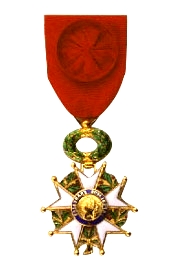
- 1804: Dominique Jean Larrey
- 1804: François-Joseph d'Offenstein
- before 1809: Alexandre Méchin
- 1811: Étienne André François de Paule Fallot de Beaumont de Beaupré
- 1812: André Raguettly
- 1815: Jean Louis Antoine Alexandre Chastelain de Verly
- 1815: Friedrich Ludwig Wilhelm Christian Karl von Tabor
- 1817: Florian von Seydlitz
- 1821: François Joseph Bosio
- 1827: Johann Gottfried Tulla
- 1850: Joseph Récamier
- 1851: Joseph-Frédéric-Benoît Charrière
- 1859: Faustin Hélie
- 1867: Alphonse Royer
- 1870: Nicolas Gosse
- 1878: Gabriel Davioud
- 1878: Henri Opper de Blowitz
- 1881: Ernest Besnier
- 1889: Hubert von Herkomer
- 1894: Jean Béraud
- 1895: Rosa Bonheur
- 1900: Arthur Constantin Krebs
- 1901: Valentin Joseph Boussinesq
- 1903: Charles Ephrussi
- 1907: Napoléon Schroeder
- 1911: Lucien Simon
- before 1912: Gustav von Schoeller
- 1912: George Broca
- 1913: Jean Noté
- 1914: Henri Bergson
- 1915: Milan Rastislav Štefánik
- 1919: Pierre Teilhard de Chardin
- 1923: Georges Goursat
- 1927: Jeremiah Denis Matthias Ford
- 1931: Georges Durand
- 1933: Édouard Branly
- 1939: Jules Supervielle
- 1946: Mathilde Paravicini
- 1959: Otto Hahn
- 1959: Max von Laue
- 1959: Konrad Loerke
- 1960: Jean Gabin
- 1966: Helmut Coing
- 1966: Max Ernst
- 1971: Marlene Dietrich
- 1980: Patrick Baudry
- 1981: David Kenworthy, 11th Baron Strabolgi
- 1984: André Castelot
- 1986: Marcel Marceau
- 1995: Colette Besson
- 1999: Robert Parker
- 1999: Jean Chalamon
- 2000: Wolfgang A. Herrmann
- 2000: Walter Veltroni
- 2001: Hartmut Mehdorn
- 2001: Petra Roth
- 2001: Tomi Ungerer
- 2004: Jean Reno
- 2004: Andrew Victor Schally
- 2004: Josef Pühringer
- 2004: Wolf Lepenies
- 2005: Ulrich Wickert
- 2005: André Gayot
- 2005: Nicolas Hayek
- 2006: Wolfgang Wosolsobe
- Before 2007: André Migdal
- 2007: Beate Klarsfeld
- 2007: David Lynch
- 2007: Enrico Macias
- 2007: Amitabh Bachchan
- 2007: Barbra Streisand
- 2007: Philippine de Rothschild-Sereys
- 2007: Aimé Jacquet
- 2008: Giorgio Armani
- 2008: Jacques Delcourt
- 2008: Thomas Treu
- 2009: Günter Gloser
- 2009: Gunther Krichbaum
- 2009: Bernadette Lafont
- 2009: Georg Nachtsheim
- 2009: Zinédine Zidane
- 2010: Martin Schulz
- 2010: Michael Schumacher
- 2011: Mireille Mathieu
- 2011: Pascal Couchepin
- 2012: Edmund Entacher
- 2012: Kurt W. Liedtke
- 2012: Paul McCartney
- 2012: Hubert Burda
- 2012: Christine Lagarde
- 2013: René Obermann
- 2013: Liz Mohn
- 2016: Annegret Kramp-Karrenbauer
- 2019: Manfred Nielson
Chevalier de la Legion d'Honneur (Ch.LH)
- 1804: Johann Wilhelm Gottfried von Lommessem
- 1805: Johann Friedrich Jacobi
- 1808: Johann Wolfgang von Goethe
- 1808: Christoph Martin Wieland
- 1808: Johann Christian Stark the Elder
- 1808: Jean Louis Antoine Alexandre Chastelain de Verly
- 1810: Jean-Denis-François Camus
- 1810: Cornelius of Guaita
- 1812: Baltasar Bundi
- 1816: Abraham Louis Breguet
- 1821: Pierre André Latreille
- 1823: Joseph Récamier
- 1824: Heinrich Karl Rosenstiel
- 1824: Frédéric Cailliaud
- before 1825: Friedrich Heinrich von Friedrich von der Leyen
- 1827: François-Frédéric Lemot
- 1828: Nicolas Gosse
- 1829: Louis Adam
- 1844: Charles Valentine Riley
- 1844: Alphonse Royer
- 1845: Louis Clément François Breguet
- 1845: Émile Prisse d'Avesnes
- 1846: Federico de Madrazo y Kuntz
- 1849: Marcel Jérôme Rigollot
- 1851: Marie-Angélique Duchemin
- 1853: Arthur Dinaux
- 1855: Jean-Marie Vianney
- 1856: Rudolf Keyser
- 1858: Jean-Joseph Zéphirin Gerbe
- 1860: Félix Billet
- 1863: Nikolai Yegorowitsch Swertschkow
- 1865: Eugène Ernest Hillemacher
- 1867: Jules Brunet
- 1867: Émile Vaudremer
- 1870: Antoine Béchamp
- 1871: Ulrich Ochsenbein
- 1875: Georges Bizet
- 1877: Karl Bodmer
- 1877: Johann Strauss (son)
- 1878: Albert Anker
- 1878: Étienne Prosper Berne-Bellecour
- 1878: Felix von Luschan
- 1879: Jean-Maurice-Émile Baudot
- after 1879: Alfred Cluysenaar
- 1882: Charles Ephrussi
- 1886: Paul Séjourné
- 1888: Hermann Jaeger
- 1889: Charles Bourseul
- 1889: Anders Zorn
- 1892: George Broca
- 1892: Henri-Paul Motte
- 1895: Eugène Ménégoz
- 1897: Désiré André
- 1898: Charles Balten
- 1900: Agathon Léonard
- 1901: Lucien Simon
- 1901: Alfons Mucha
- 1904: Emile Claus
- 1906: Louis Bernacchi
- 1908: Albert Bettannier
- 1912: Olga Boznańska
- 1914: Mustafa Kemal Pascha
- 1919: Auguste Escoffier
- 1920: Marie-Louise Ruedin
- 1922: Lyman Abbott , Camille Benoît , Anna Branting
- 1930: Antoine de Saint-Exupéry
- 1933: Elizabeth Alice Le Blond
- 1935: Walt Disney
- 1935: Wolfgang Himmelbaur
- 1935: Stendhal
- 1945: Jack Agazarian
- 1945: Adolf Mayer
- 1947: Nancy Cunard
- 1947: Auguste Delaune
- 1947: Janet Flanner
- 1948: Charles Boyer
- 1948: Berthe Weill
- 1950: Marlene Dietrich
- 1953: Charles le Maistre
- 1953: Charles Faroux
- 1953: Georges Jouatte
- 1954: Jean-Marie Balestre
- 1960: Hans Arp
- 1962: Antonin Magne
- 1966: Jacques Anquetil
- 1967: Tomasi Kulimoetoke II.
- 1967: Oscar Niemeyer
- 1973: Louis de Funès
- 1978: Heinz Weil
- 1985: Talal Abu-Ghazaleh
- 1985: Miguel Ángel Estrella
- 1987: Gae Aulenti
- 1988: Barbara ( Monique Andrée Serf )
- 1989: Léon Poliakov
- 1990: Michel Schwalbé
- 1991: Alfred Courmes
- 1992: Myung-whun Chung
- 1993: Eddy Marnay
- 1994: France Gall
- 1994: Paul Haeberlin
- 1994: Bernard Loiseau
- 1995: Louis de Cazenave
- 1995: Sivaji Ganesan
- 1997: Jost Prüm
- 1997: Marta Pan
- 1998: Fabien Barthez
- 1998: Ernst Beyeler
- 1998: Claude Jade
- 1999: Jean-Claude Thoenig
- 1999: Paulo Coelho
- 2000: Constantin Andreou
- 2000: Heinz Stahlschmidt ( Henri Salmide )
- 2000: Elias Chacour
- 2001: Liliane Bettencourt
- 2001: Anthony Atkinson
- 2001: Pierre Audi
- 2001: Flor Isava Fonseca
- 2001: Hardy Kruger
- 2002: Pierre Arditi
- 2002: Sabine Christiansen
- 2002: Arsène Wenger
- 2003: Ernesto Bertarelli
- 2003: Bono
- 2003: Guy Martin
- 2003: Wolfgang Tiefensee
- 2003: Frank Buckles
- 2004: Walter Homolka
- 2004: Alice Schwarzer
- 2004: Claudia Roth
- 2004: Gerhard Leo
- 2004: Michał Gutowski
- 2004: Peter Altmaier
- 2004: Reinhold Würth
- 2005: Montserrat Caballé
- 2005: Ivan Ćurković
- 2005: Herbert Schmalstieg
- 2005: Peter Scholl-Latour
- 2005: E. Sreedharan
- 2005: Margret Wintermantel
- 2006: Pierre Alechinsky
- 2006: Yann Arthus-Bertrand
- 2006: Reinhold Robbe
- 2006: Valentino Garavani
- 2007: Léo pharmacist
- 2007: Waris Dirie
- 2007: Christine Albanel
- 2007: Isaac de Bankolé
- 2007: Pierre Brice
- 2007: Roger Beaufrand
- 2007: Celine Dion
- 2007: Pierre Hermé
- 2007: Jobst Plog
- 2007: Ronald Searle
- 2007: Julio Iglesias
- 2007: Elisabeth Eidenbenz
- 2008: Ellen MacArthur
- 2008: Íngrid Betancourt
- 2008: Roland Mack
- 2008: Olga Swiblowna
- 2008: China Zorrilla
- 2009: Sébastien Loeb
- 2009: José Antonio Abreu
- 2009: Rainer Haas
- 2009: Lóránd Hegyi
- 2009: Matthias Wissmann
- 2009: Helmut Claas
- 2009: Joanne K. Rowling
- 2010: Erró
- 2010: Tony Fernandes
- 2010: Olivia de Havilland
- 2010: Serge Gut
- 2010: Emir Kusturica
- 2010: Anneliese Poppinga
- 2010: Robert Redford
- 2010: Simon Rattle
- 2010: Wolfgang Wagner
- 2010: Diane Duchess of Württemberg
- 2010: Toni Morrison
- 2011: Brigitte Fassbaender
- 2011: Arvo Pärt
- 2012: Georg Baselitz
- 2012: Corinne Goddijn-Vigreux
- 2012: Michael Haneke
- 2012: Nicola Leibinger-Kammüller
- 2012: Rupert Neudeck
- 2012: Theo Öhlinger
- 2012: Nano Ruzhin
- 2012: Salma Hayek
- 2013: Mélanie Berger-Volle
- 2013: Peter Engelmann
- 2013: Thaddaeus Ropac
- 2013: Harald Schmidt
- 2013: Klaus-Heinrich Standke
- 2014: Helen Patton-Plusczyk
- 2014: Shah Rukh Khan
- 2015: Latifa Ibn Ziaten
- 2016: Alice Greyer-Wieninger
- 2016: Ernst Delp
- 2016: Rolf-Dieter Heuer
- 2017: Gudrun Gersmann
- 2018: Geneviève Callerot
- 2018: Martin Richenhagen [15]
- 2018: Daniela Schwarzer
- 2020: Christine Ferber
Refusals of the Order
- The staff of the satirical newspaper Le Canard enchaîné have always rejected decorations from medals, primarily those from the Legion of Honor. The journalist Pierre Scize was fired in 1933 for accepting him.
- The dramaturge Népomucène Lemercier refused to take the oath on the emperor and his dynasty . Lafayette and the poet Jean-François Ducis , Gérard de Nerval , George Sand , Honoré Daumier , Émile Littré , Gustave Courbet and Guy de Maupassant rejected the acceptance, Maurice Ravel gave it back without explanation. Pierre and Marie Curie , Eugène Le Roy, Jean-Paul Sartre , Simone de Beauvoir , Albert Camus , Antoine Pinay are among the other objectors. Brigitte Bardot received an award in 1985 but refused to appear for the award, as did Catherine Deneuve and Claudia Cardinale .
-
Anarchist poets rejected the award, as did Jacques Prévert , Georges Brassens , who wrote a chanson about it, or Léo Ferré , who scoffed at “this unfortunate bond that is red as shame”.
Geneviève de Fontenay, on the other hand, the president of Miss France , was proposed by a Savoyard MP and refused out of modesty: "To give this ribbon to anyone ... like a chocolate medal is really a dishonor for the Order." - The late 1997 award-winning writer Bernard Clavel had let it be known that he would not accept the order and would prefer to belong to the "clan of those who refused it". He added that it was given to his uncle Charles because he had poured his blood into rivers in a terrible war for his country. "I think he would turn around in his grave if he knew I was wearing the same band as him."
- Vincent Auriol , President of the Republic, suggested the writer Marcel Aymé for the Legion of Honor in 1949 . Aymé replied in 1950 in the satirical magazine Le Crapouillot, verbose, polite and coarse at the same time: "... I would ask you to be willing to put your Legion of Honor elsewhere ..." ( ... je les prierais qu'il voulussent bien, leur Légion d'honneur , se la carrer dans le train… ) Aymé's reply has been quoted many times and has become famous over the years.
- There are also people who accept the medal but refuse to wear it, for example Jean d'Ormesson from the Académie française .
The poor relief worker Abbé Pierre was appointed Grand Officer of the Legion of Honor in 1992. Although he did not refuse the award, he refused to wear it until 2001 in protest of the French state's refusal to allocate empty apartments to the homeless. In 2004 he was named bearer of the Grand Cross of the Legion of Honor. - The President of the Turkish University Council, Erdoğan Teziç , has returned the commander's award given to him on July 17, 2004 by French President Jacques Chirac. Erdoğan Teziç cited the passing of the law that criminalized the denial of the Armenian genocide as the reason for the return .
- Michèle Audin refused to accept membership in the Legion of Honor in 2009 because the French President had not responded to a request from her mother to come to terms with her father's fate. Her father Maurice Audin was tortured to death by French paratroopers in Algeria in 1957. No person responsible for this murder was held accountable.
- Economist Thomas Piketty turned down the nomination for the Legion of Honor on January 1, 2015.
- Geneviève Callerot has long refused to accept the medal "because there are tons of people who deserve them much more," but accepted it on August 26, 2018 on the condition that posthumously "their parents and siblings are included." Callerot's family helped in the Second world war, more than 200 people, including many Jews to flee the from the Nazis occupied south-west France Dordogne in the unoccupied zone of France .
Legion of Honor Museum
That for Prince Friedrich III. The Hôtel de Salm , built by Salm-Kyrburg , has been the seat of the Legion of Honor since May 13, 1804 and houses their museum.
Curiosities
One animal also received the highest award. During the First World War near Verdun, a pigeon was the last carrier pigeon to bring the request for the relief of the soldiers trapped in Fort Vaux to their destination on June 6, 1916, but died on the same day due to the inhaled combat gases. She received the red ribbon posthumously.
The Legion of Honor in Heraldry
With the proclamation of the French Empire, a reform of the coat of arms was carried out. The insignia of the Legion of Honor could now be used in state, municipal and family coats of arms; the different classes were heraldically precisely differentiated.
First Empire
1804–1814 / 15
Collane of the Legion of HonorSecond Empire
1852–1870
Collane of the Legion of Honor
- Communal heraldry
Belfort city coat of arms
Coat of arms of the city of Dijon (until 1962)
Coat of arms of the city of Rambervillers
Web links
- Official website of the Legion of Honor (French)
- Musée national de la Légion d'honneur et des ordres de chevalerie and L'histoire (French)
- SMLH - Société des Membres de la Légion d'Honneur (French)
- Base Léonore : database of winners with search function; awards from 1802 and medal holders who died before 1977 are recorded. (French, registration required)
- Jean-Claude Guégand: La légion d'honneur. Histoire de l'ordre. ( Memento of February 15, 2019 in the Internet Archive ), (French)
- The symbol: the Legion of Honor. ( Memento from March 22, 2014 in the Internet Archive ) In: arte .tv , June 1, 2008
- Legion of Honor in the magazine of the German Historical Museum
Individual evidence
- ↑ Volker Saux: The symbol: the Legion of Honor. ( Memento from March 22, 2014 in the Internet Archive ) In: arte .tv , June 1, 2008.
- ↑ Brief overview: L'ordre national de la légion d'honneur. ( Memento from June 11, 2012 in the Internet Archive ). In: Préfecture de la Somme , (PDF), see chapter: La décoration à titre collectif .
- ↑ a b Légion d'honneur: ceux qui l'ont refusée: 4. L'Abbé Pierre. In: bfmtv.com , September 24, 2018, (French), accessed on February 16, 2020.
- ^ A b Leo Klimm: At the court of Paris. In: Süddeutsche Zeitung . April 14, 2015, accessed February 16, 2020 .
- ^ Dieter Althaus: My curriculum vitae. ( Memento from May 15, 2019 in the Internet Archive ). In: dieter-althaus.de .
- ↑ Scrittori: Umberto Eco all'Eliseo onorato da Sarkozy with Legion d'Honneur. ( Memento from August 29, 2014 in the Internet Archive ). In: Libero Quotidiano , January 13, 2012, (Italian).
- ^ A b Association des Anciens Elèves du Lycée Charlemagne: Elie Broca (1814-1887). ( Memento of July 1, 2019 in the Internet Archive ). In: Lycée Charlemagne , Paris.
- ↑ Appointment files for Albert Bettannier. In: Base Léonore - Ministère de la culture , accessed on February 15, 2020.
- ^ Laudation by Arndt Sorge : Honorary Member 2005: Jean-Claude Thoenig. ( Memento from September 23, 2015 in the Internet Archive ). In: European Group for Organizational Studies ( EGOS ), 2005.
- ↑ jnb / AFP : Joanne K. Rowling made a knight. In: Tagesspiegel , February 4, 2009.
- ↑ Harald Schmidt appointed Knight of the Legion of Honor. ( Memento of March 4, 2016 in the Internet Archive ). In: French Embassy in Berlin , May 6, 2013.
- ^ Rolf Heuer awarded prestigious French honor. In: Cern , December 13, 2016.
- ↑ Gudrun Gersmann, former director of DHIP, receives French Order of Merit. In: German Historical Institute Paris ( DHIP ), February 21, 2017.
- ↑ 102-year-old French woman accepted into the Legion of Honor. In: orf.at , August 26, 2018, accessed on February 16, 2020.
- ↑ Honors for DGAP scientists. In: German Society for Foreign Policy (DGAP). January 24, 2019, accessed February 15, 2020 .
- ↑ Cyrille Frank: Légion d'Honneur: quelles célébrités l'ont refusée? In: La Dépêche , April 10, 2012.
- ↑ a b AFP : De Sartre à Bardot: des personnalités qui ont refusé la Légion d'honneur. In: Le Point , January 1, 2015, (French).
- ^ Nicolas Guégan, Grégoire Leménager: Légion d'Honneur: Tardi se la carre au train. In: Nouvel Observateur , January 2, 2013.
- ↑ Gabrielle Rolin: Marcel Aymé savait refuser avec panache. In: L'Express , June 1, 2001: “Et pendant que j'y serais, pour n'avoir plus à y revenir, pour ne plus me trouver dans le cas d'avoir à refuser d'aussi adorables faveurs, ce qui me cause nécessairement une grande peine, je les prierais qu'ils voulussent bien, leur Légion d'honneur, se la carrer dans le train comme aussi leurs plaisirs élyséens. »Translation:“ And while I'm at it, so that I don't have to come back to it, so that I don't have to refuse such lovable favors that necessarily cause me great pain, I would ask you to be willing to join your Legion of Honor elsewhere, as well as their Elysian joys. "
- ↑ Jonathan Bouchet-Petersen: Légion d'honneur: Piketty ignorait qu'il allait être promu. In: Liberation , January 1, 2015: “réplique fameuse”.
- ↑ President of the Turkish University Council returned the French award . In: Wikinews , October 17, 2006.
- ↑ Audin's reply to Sarkozy: La lettre de Michèle Audin à Nicolas Sarkozy. In: mediapart .fr , January 2, 2009, (French).
- ^ Christian Schubert: Star economist Thomas Piketty: "It is not the government that decides who is to be honored". In: FAZ.net , January 2, 2015.
- ↑ 102-year-old French woman accepted into the Legion of Honor. In: orf.at , August 26, 2018, accessed on February 16, 2020.
- ↑ Sven Felix Kellerhoff : Everyone sees himself in front of his grave . In: Die Welt , November 21, 2006, on the ZDF film “The Hell of Verdun ”.


